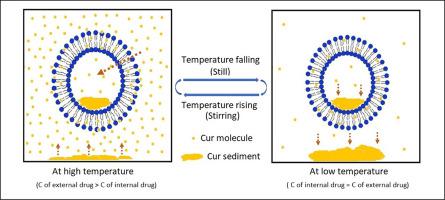Biomaterials Advances ( IF 5.5 ) Pub Date : 2021-08-19 , DOI: 10.1016/j.msec.2021.112379 Yuanyuan Qi 1 , Can Wang 1 , Rui Qian 1 , Minnan Chen 1 , Pingping Jiang 1 , Ting Wang 1 , Ning Wang 2

|
Liposomes are a useful carrier for delivering drugs but rarely make a poorly water-soluble drug (PWSD) realize its therapeutic potential. A key barrier lies in that, by conventional methods, PWSD is mainly loaded just in liposome bilayer membranes, which rarely provide sufficient room to accommodate drugs satisfying clinical therapy. In this investigation, a novel procedure of temperature up-down cycle (TUDC) was developed for loading PWSDs into the liposome interiors instead of bilayer membranes to hold enough agents. In particular, the TUDC procedure renders PWSDs such as curcumin (Cur) entrapment purposely controllable, as evidenced by the encapsulation efficiency (EE) of Cur varies nearly from 0% to 100% in response to changes the determinant factors of the procedure. In addition, several mathematical equations that could calculate the loading efficiency by TUDC were established and proved, when combined with thermodynamic process, able to successfully predict the loading results through including thermodynamic parameters, such as temperature and deduced drug solubility, thus remarkably cutting down the laborious experiments and enhancing liposome development efficiency. Cryo-TEM, SAXS, XRD and DSC tests proved that TUDC is feasible to load a PWSD into PEG-liposomes but rendering the drug in the amorphous state. Thus, the novel TUDC procedure and the established mathematical and thermodynamic process may provide a useful tool to promote the development of liposome products.
中文翻译:

通过温度上下循环程序将药物加载到脂质体中,结果可控,通过数学和热力学过程拟合预测
脂质体是一种有用的药物载体,但很少使水溶性差的药物 (PWSD) 发挥其治疗潜力。一个关键的障碍在于,通过常规方法,PWSD 主要负载在脂质体双层膜中,很少提供足够的空间来容纳满足临床治疗的药物。在这项研究中,开发了一种新的温度升降循环 (TUDC) 程序,用于将 PWSD 加载到脂质体内部而不是双层膜中以容纳足够的试剂。特别是,TUDC 程序使 PWSDs,如姜黄素 (Cur) 诱捕有目的地可控,如 Cur 的封装效率 (EE) 从 0% 变化到 100%,以响应该程序的决定因素的变化。此外,建立并证明了几个可以计算TUDC加载效率的数学方程,结合热力学过程,可以通过包括温度和推导的药物溶解度等热力学参数成功预测加载结果,从而显着减少了繁琐的实验和提高脂质体开发效率。Cryo-TEM、SAXS、XRD 和 DSC 测试证明 TUDC 可将 PWSD 加载到 PEG 脂质体中,但使药物处于无定形状态。因此,新的 TUDC 程序和已建立的数学和热力学过程可能为促进脂质体产品的开发提供有用的工具。通过包括温度和推导的药物溶解度等热力学参数,能够成功预测加载结果,从而显着减少了繁琐的实验并提高了脂质体开发效率。Cryo-TEM、SAXS、XRD 和 DSC 测试证明 TUDC 可将 PWSD 加载到 PEG 脂质体中,但使药物处于无定形状态。因此,新的 TUDC 程序和已建立的数学和热力学过程可能为促进脂质体产品的开发提供有用的工具。通过包括温度和推导的药物溶解度等热力学参数,能够成功预测加载结果,从而显着减少了繁琐的实验并提高了脂质体开发效率。Cryo-TEM、SAXS、XRD 和 DSC 测试证明 TUDC 可将 PWSD 加载到 PEG-脂质体中,但使药物处于无定形状态。因此,新的 TUDC 程序和已建立的数学和热力学过程可能为促进脂质体产品的开发提供有用的工具。XRD 和 DSC 测试证明 TUDC 可以将 PWSD 加载到 PEG-脂质体中,但使药物处于无定形状态。因此,新的 TUDC 程序和已建立的数学和热力学过程可能为促进脂质体产品的开发提供有用的工具。XRD 和 DSC 测试证明 TUDC 可以将 PWSD 加载到 PEG-脂质体中,但使药物处于无定形状态。因此,新的 TUDC 程序和已建立的数学和热力学过程可能为促进脂质体产品的开发提供有用的工具。











































 京公网安备 11010802027423号
京公网安备 11010802027423号